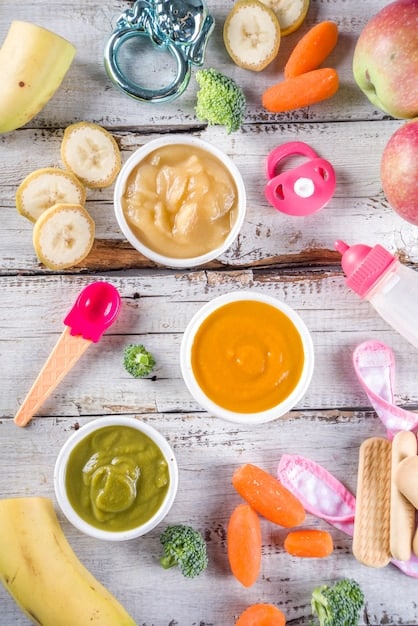Is Your Baby Refusing Solids? 5 Proven Strategies for Picky Eaters

Is your baby refusing solids? Discover five proven strategies, from creating a positive feeding environment to introducing diverse flavors, to encourage your baby to accept and enjoy solid foods.
Navigating the world of baby feeding can be challenging, especially when your little one starts refusing solids. It’s a common concern that can leave parents feeling frustrated and unsure of what to do. But don’t worry, you’re not alone! Understanding why your baby might be rejecting solid foods and implementing the right strategies can make all the difference. Let’s explore some practical tips to encourage your baby to enjoy meal times and embrace new tastes, making the transition to solids a smoother experience for both of you. We selected 5 proven strategies to encourage eating
Understanding Why Your Baby Might Be Refusing Solids
Before diving into the strategies, it’s essential to understand why your baby might be refusing solids. This could stem from various reasons, including developmental stages, sensory sensitivities, or even simple preferences. Recognizing the potential causes can help you tailor your approach and make meal times more enjoyable for your little one.
Developmental Readiness
Babies develop at their own pace, and what works for one might not work for another. Understanding the signs of developmental readiness is crucial before introducing solids.
Possible Reasons for Food Rejection
- New Tastes and Textures: Babies are used to the familiar taste and texture of breast milk or formula. Introducing new flavors and consistencies can be overwhelming.
- Teething Discomfort: Teething can make gums sore and eating uncomfortable, leading to food refusal.
- Illness or Discomfort: A cold, ear infection, or any general discomfort can decrease appetite temporarily.
- Sensory Sensitivities: Some babies are more sensitive to textures, temperatures, or smells.
Understanding these factors is the first step in addressing your baby’s refusal of solids and creating a positive feeding environment.

Creating a Positive Feeding Environment
A positive and relaxed feeding environment can significantly impact your baby’s willingness to try new foods. Babies are sensitive to their surroundings and can pick up on your stress or anxiety. By making meal times a pleasant experience, you can encourage them to be more open to trying solids.
Tips for a Relaxed Meal Time
The key is to minimize distractions and create a calm setting where your baby feels safe and supported.
- Minimize Distractions: Turn off the TV, put away toys, and focus solely on the meal.
- Be Patient: Avoid pressuring your baby to eat. Offer the food and allow them to explore it at their own pace.
- Make it Social: Eat together as a family. Babies often mimic what they see, so seeing you enjoy your food can encourage them to try theirs.
- Positive Reinforcement: Praise your baby for trying new foods, even if they only take a small bite. Avoid negative comments or scolding.
By creating a positive environment, you set the stage for a more successful and enjoyable transition to solids.
Introducing New Foods Gradually
Introducing new foods gradually is a fundamental strategy in ensuring your baby accepts solids. It allows them to adjust to new tastes and textures without feeling overwhelmed. Starting with simple, single-ingredient purees is often the best approach.
Starting with Single-Ingredient Purees
Begin with vegetables and fruits that are naturally sweet and easy to digest.
Introduce one new food at a time, waiting a few days before introducing another. This helps you identify any potential allergies or sensitivities. The process of introducing new food should be gradual, easy and with patience.
Tips for Gradual Introduction
- Start Small: Offer just a spoonful or two of the new food.
- Be Consistent: Offer the new food for several days in a row to give your baby a chance to get used to the taste.
- Mix with Familiar Foods: If your baby seems hesitant, mix the new food with breast milk or formula to make it more palatable.
Gradually introducing a variety of foods helps your baby develop a diverse palate and ensures they receive a broad range of nutrients.

Exploring Different Textures and Flavors
As your baby becomes more comfortable with simple purees, it’s time to explore different textures and flavors. This helps them develop their oral motor skills and expand their palate. Gradual texture progression is key to keep your baby engaged and curious about meal times.
Progressing from Purees to Lumpy Foods
Once your baby is comfortable with smooth purees, gradually introduce chunkier textures.
As your baby gets used to these textures, you can move on to soft, mashed foods like avocado, banana, or well-cooked sweet potato.
Introducing a Variety of Flavors
Don’t be afraid to introduce a wide range of flavors from different food groups.
- Experiment with Herbs and Spices: Add small amounts of herbs like cinnamon, nutmeg, or basil to your baby’s food to introduce new flavors.
- Combine Different Foods: Mix vegetables and fruits together to create unique flavor combinations.
- Offer Variety: Rotate through different foods regularly to keep your baby interested and prevent them from becoming bored with the same flavors.
By continually introducing new textures and flavors, you encourage your baby to become a more adventurous and less picky eater.
Making Meal Times Interactive and Fun
Meal times should be more than just about eating; they should be an opportunity for interaction and fun. This can help your baby associate positive emotions with food and make them more willing to try new things.
Engaging Your Baby During Meals
Make meal times an interactive experience by using playful strategies.
Sing songs, make funny faces, or tell stories to keep your baby entertained. Make sure to focus on the positive.
Tips for Interactive Feeding
- Self-Feeding Opportunities: Allow your baby to explore food with their hands. This encourages independence and sensory exploration.
- Use Colorful Utensils and Plates: Bright and attractive tableware can make meal times more appealing.
- Play Games: Turn meal times into a game by making airplane noises with the spoon or playing peek-a-boo with the food.
Meal times should be less about feeding and more about enjoying. With the strategies above, your time with your baby learning about solids should become easier.
Knowing When to Seek Professional Advice
While most babies will eventually adapt to solid foods, there are times when seeking professional advice is necessary. If you have concerns about your baby’s eating habits or suspect an underlying medical condition, it’s always best to consult a pediatrician or a feeding specialist.
Signs That Warrant a Doctor’s Visit
Watch out for any of the following signs, as these may require professional help.
When to Consult a Feeding Specialist
- Persistent Refusal of All Solids: If your baby consistently refuses to eat any solid foods despite your best efforts.
- Oral Motor Difficulties: Issues with chewing, swallowing, or coordinating tongue movements.
- Failure to Thrive: If your baby is not gaining weight or growing at a healthy rate.
Seeking professional advice can provide you with tailored strategies and support to address any underlying issues and ensure your baby receives adequate nutrition.
| Key Point | Brief Description |
|---|---|
| 😊 Positive Environment | Create a calm mealtime with minimal distractions. |
| 🥄 Gradual Introduction | Introduce one new food at a time to monitor allergies. |
| 🍎 Diverse Textures | Offer a variety of textures as baby gets comfortable. |
| 🎉 Fun Meal Times | Incorporate games and positive interactions to attract baby’s attention. |
What are common reasons for baby’s food refusal? ▼
Common reasons include new tastes and textures, teething discomfort, illness, or food sensitivities. Understanding the cause can help you tailor your approach.
How can I create a positive feeding environment? ▼
Minimize distractions during meal times, such as turning off the TV and putting away toys. Be patient and avoid pressuring your baby to eat.
What’s the best way to introduce new foods? ▼
Start with single-ingredient purées and introduce one new food at a time, waiting a few days before introducing another to monitor for allergies.
How do I transition my baby from purées to solids? ▼
Gradually introduce chunkier textures as your baby gets comfortable with smooth purées. Mashed foods like avocado or sweet potato are good options.
When should I seek professional help for my baby’s feeding issues?
If your baby persistently refuses all solids, show signs of oral motor difficulties, or is not gaining weight at a healthy rate, consult a pediatrician or feeding specialist.
Conclusion
Addressing a baby’s refusal of solids requires patience, understanding, and a tailored approach. By creating a positive feeding environment, gradually introducing a variety of flavors and textures, and making meal times interactive and fun, you can help your baby develop healthy and diverse eating habits. Remember to seek professional advice if you have concerns about your baby’s nutrition or development.





